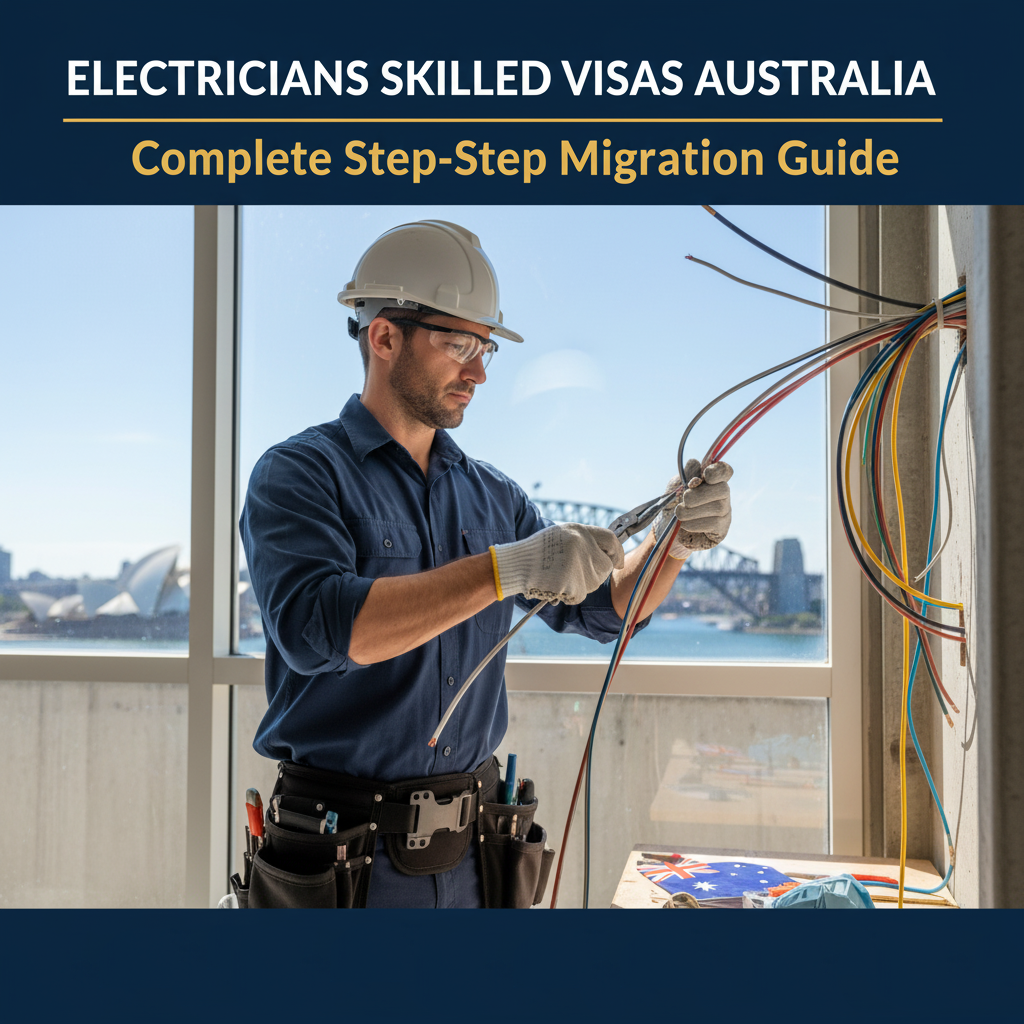A detailed step-by-step guide on electricians skilled visas in Australia, covering skills assessment, visa pathways, licensing, and practical tips for successful migration.
Introduction
Australia’s booming construction and infrastructure sectors have created a significant demand for skilled electricians. This demand translates into excellent migration opportunities for qualified electricians worldwide. However, the migration process involves multiple steps, including skills assessment, visa applications, and licensing requirements. This comprehensive guide provides a detailed, step-by-step overview of the electricians skilled visas Australia process, helping you navigate the journey smoothly and build a rewarding career.
Step 1: Understanding the Electrician Occupation and Visa Eligibility
Electricians in Australia are classified under the ANZSCO code 341111 (Electrician – General). This classification is critical as it determines your eligibility for various skilled migration visas.
Skilled Occupation Lists and Visa Options
Electricians are listed on Australia’s Skilled Occupation List (SOL) and Consolidated Sponsored Occupation List (CSOL), making them eligible for several visa subclasses:
- Subclass 189 (Skilled Independent Visa): Points-tested visa without sponsorship.
- Subclass 190 (Skilled Nominated Visa): Requires nomination by an Australian state or territory, adding 5 points.
- Subclass 491 (Skilled Work Regional (Provisional) Visa): For those willing to live and work in regional Australia, with a pathway to permanent residency.
- Subclass 482 (Temporary Skill Shortage Visa): Employer-sponsored temporary visa, often a pathway to permanent residency.
- Subclass 186 (Employer Nomination Scheme): Employer-sponsored permanent residency visa.
Eligibility Criteria
To qualify for these visas, electricians must:
- Obtain a positive skills assessment from Trades Recognition Australia (TRA) or VETASSESS.
- Score a minimum of 65 points on the General Skilled Migration points test.
- Demonstrate English language proficiency through IELTS, PTE, or OET.
- Pass health and character checks.
Step 2: Completing the Electrician Skills Assessment
The skills assessment is a mandatory step that verifies your qualifications and work experience meet Australian standards.
Assessment Authorities and Process
- Trades Recognition Australia (TRA) is the primary assessing authority for electricians.
- The assessment involves two stages:
- Document Review: Submission of certified qualifications, employment references, payslips, and tax documents.
- Practical and Technical Interview: A hands-on practical test and technical interview assess your skills and knowledge.
Qualification and Experience Requirements
- At least 6 years of relevant work experience without formal training, or
- At least 4 years of relevant work experience with formal electrical training (e.g., apprenticeship or certificate).
Outcome
Successful candidates receive an Offshore Technical Skills Record (OTSR) and a skills assessment letter, required for visa applications and licensing.
Step 3: Meeting English Language Requirements
English proficiency is essential for effective communication and workplace safety.
Accepted Tests and Scores
- IELTS Academic: Minimum 7.0 in reading and writing, 8.0 in speaking and listening.
- Occupational English Test (OET): Minimum grade B in all components.
- PTE Academic and TOEFL iBT with equivalent scores.
Applicants from certain English-speaking countries may be exempt.
Step 4: Submitting an Expression of Interest (EOI) and Applying for a Visa
Once you have a positive skills assessment and meet English requirements, submit an EOI through SkillSelect.
Choosing the Right Visa
- Subclass 189: Independent skilled visa without sponsorship.
- Subclass 190: Requires state or territory nomination, which adds 5 points.
- Subclass 491: Regional visa encouraging migration to less populated areas with extra points.
- Subclass 482: Employer-sponsored temporary visa.
- Subclass 186: Employer nomination for permanent residency.
Visa processing times vary, generally between 6 and 12 months.
Step 5: Obtaining Licensing and Work Rights in Australia
To work legally as an electrician, you must obtain a state or territory electrical license.
Licensing Requirements
- Valid skills assessment and visa.
- Provisional license to work under supervision initially.
- Completion of gap training covering Australian electrical standards and workplace safety.
- Full license granted after meeting all regulatory requirements.
Licensing authorities vary by state, including NSW Fair Trading, Victorian Building Authority, and others.
Step 6: Navigating Common Challenges
Documentation and Evidence
Prepare detailed, certified documents for skills assessment and visa applications to avoid delays.
Practical Skills and Standards
Familiarize yourself with Australian electrical codes and safety regulations before your practical assessment.
English Language
Achieving the required language proficiency can be challenging; professional coaching is recommended.
Visa Selection
Research visa subclasses carefully based on your circumstances and state nomination opportunities.
Regional Migration
Consider regional visas for faster processing, additional points, and better job prospects.
Step 7: Maximizing Your Migration Success
- Start early with skills assessment and document preparation.
- Invest in English language training.
- Explore state nomination options and regional migration incentives.
- Engage registered migration agents for expert advice.
- Network with Australian electricians and industry groups.
Conclusion
Migrating to Australia as an electrician offers strong career prospects amid high demand. Understanding the electricians skilled visas Australia process—from skills assessment through licensing—is crucial. This step-by-step guide equips you with the knowledge to navigate the journey confidently and successfully. Begin your application now and take the first step toward a rewarding career in Australia.


